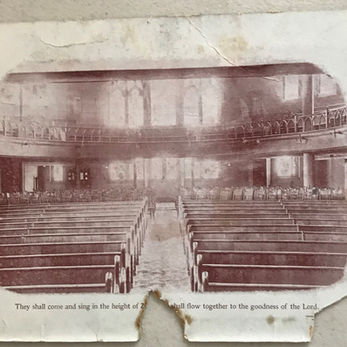

OUR HISTORY
Founded in 1841, First Lutheran Church (FLC) has been an integral part of Cincinnati's religious and cultural fabric for over 180 years.
FLC's early history is marked by significant events. In September 1841, Reverend Abram Reck, an abolitionist supporter, visited Cincinnati during a period of racial unrest and garnered support to establish the city's second Lutheran congregation. The inaugural worship service took place on December 8, 1841, on the second floor of a firehouse at Vine and Canal (now Central Parkway). The church was officially organized as the First English Evangelical Lutheran Church on February 20, 1842, stipulating that services and business be conducted in English. While the original firehouse no longer stands, Kroger's headquarters now occupies the site, serving as a reminder of FLC's humble beginnings.
Throughout its history, FLC has been known for its progressive stance. In 1848, the church allowed families to worship together, a forward-thinking move for the time when it was common for men and women to sit separately. In 1870, FLC granted women voting rights within the church, acknowledging their valuable contributions decades before women's suffrage became law in the United States. This commitment to equality and inclusion has been a hallmark of FLC's approach to faith and community.
The church's progressive nature is further exemplified by its "Seats Free" policy, implemented on January 16, 1867. When faced with financial challenges, a proposal was made to begin "renting pews" - a common practice at the time where members would pay fees for specific seats. However, this proposal was defeated, reflecting FLC's commitment to accessibility and inclusivity in worship. Instead, the church ordered two signs bearing the words "Seats Free" to be placed at each door. This policy was rooted in the belief that faith and community should be accessible to all, regardless of financial means. It demonstrated FLC's dedication to breaking down economic barriers to spiritual participation and fostering a truly inclusive congregation.
The church relocated to its current site in Over-the-Rhine in 1895 due to increasing urban noise and the growing needs of the congregation. The cornerstone of the present building was laid on June 17, 1894, and the structure was dedicated on May 12, 1895.
FLC's commitment to community has been unwavering. The tradition of openness continues today, with the church extending its "Seats Free" philosophy beyond regular worship services. FLC now hosts numerous community and arts events. FLC is committed to being a welcoming space for the entire community, not just its regular congregation.
In recent years, FLC has overcome financial challenges to become self-sustaining in 2017. Since then, the church has invested $1,300,000 in restoring its historic building. Future plans include renovations to the bell tower, installation of an elevator, and updates to the main worship space.
First Lutheran Church remains a symbol of Cincinnati's history, blending progressive values with a deep commitment to community service and cultural engagement.






TAKE A STEP THROUGH TIME...
FAMOUS FIRSTS
Throughout its history, FLC has been home to notable members who made significant contributions to Cincinnati.
Founded the Cincinnati Conservatory of Music (CCM) in 1867
Founded the Cincinnati Zoo and Botanical Gardens in 1873
Founder of First English Evangelical Lutheran Church
Original First Lutheran Church charter member in 1842
Designed renowned dessert for Marquis de Lafayette during U.S. visit in 1825
Wife to Johann Meyer. Original First Lutheran Church charter member in 1842
FLC OVER THE YEARS
Here is a unique perspective of FLC over the centuries through different mediums:
ADDITIONAL HISTORICAL DOCUMENTS
Take a dive into our assortment of past articles, stories, pictures, and more!









